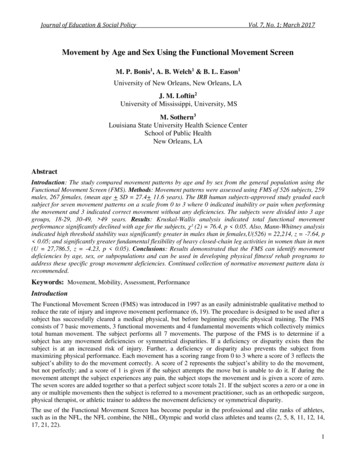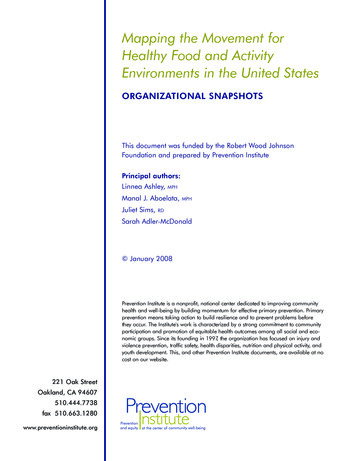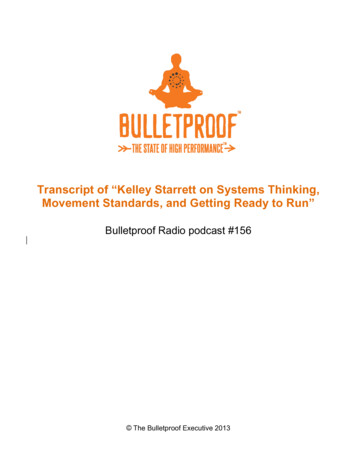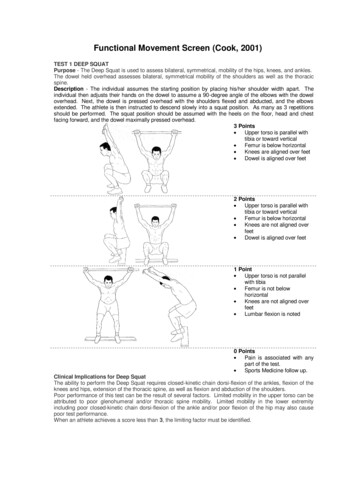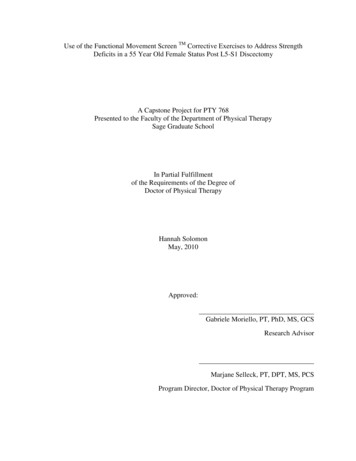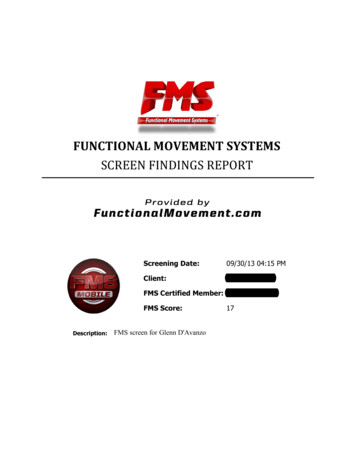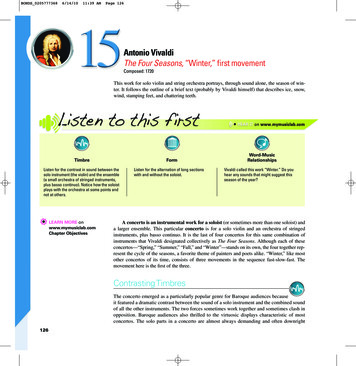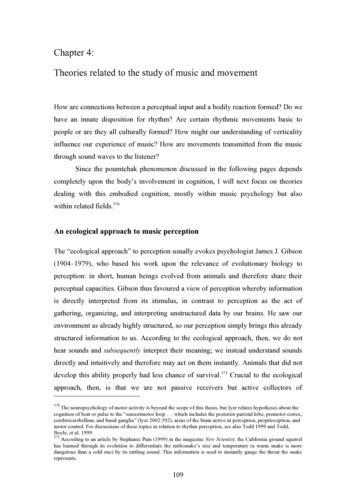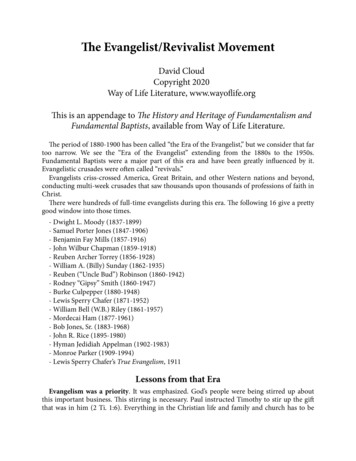
Transcription
The Evangelist/Revivalist MovementDavid CloudCopyright 2020Way of Life Literature, www.wayoflife.orgThis is an appendage to The History and Heritage of Fundamentalism andFundamental Baptists, available from Way of Life Literature.The period of 1880-1900 has been called “the Era of the Evangelist,” but we consider that fartoo narrow. We see the “Era of the Evangelist” extending from the 1880s to the 1950s.Fundamental Baptists were a major part of this era and have been greatly influenced by it.Evangelistic crusades were often called “revivals.”Evangelists criss-crossed America, Great Britain, and other Western nations and beyond,conducting multi-week crusades that saw thousands upon thousands of professions of faith inChrist.There were hundreds of full-time evangelists during this era. The following 16 give a prettygood window into those times.- Dwight L. Moody (1837-1899)- Samuel Porter Jones (1847-1906)- Benjamin Fay Mills (1857-1916)- John Wilbur Chapman (1859-1918)- Reuben Archer Torrey (1856-1928)- William A. (Billy) Sunday (1862-1935)- Reuben (“Uncle Bud”) Robinson (1860-1942)- Rodney “Gipsy” Smith (1860-1947)- Burke Culpepper (1880-1948)- Lewis Sperry Chafer (1871-1952)- William Bell (W.B.) Riley (1861-1957)- Mordecai Ham (1877-1961)- Bob Jones, Sr. (1883-1968)- John R. Rice (1895-1980)- Hyman Jedidiah Appelman (1902-1983)- Monroe Parker (1909-1994)- Lewis Sperry Chafer’s True Evangelism, 1911Lessons from that EraEvangelism was a priority. It was emphasized. God’s people were being stirred up aboutthis important business. This stirring is necessary. Paul instructed Timothy to stir up the giftthat was in him (2 Ti. 1:6). Everything in the Christian life and family and church has to be
stirred up. We have to stir up abiding in Christ, yielding to the Holy Spirit, walking in thelight, holiness, Bible study, prayer, separation from the world, evangelism, godly familyrelations, child discipline, the holy priesthood, the “one another” ministry in the body,everything. We stir it up by preaching and teaching on it, by repeating it, by emphasizing it, bymodeling it, by whispering it and by shouting it. It has well been said, “Nothing can bemaintained without a campaign.” Every leader of the church and home must be a campaignerfor all of the things that are emphasized in Scripture. This is the essence of spiritual revival. Itis something that God’s people are to walk in, live in, not something they experience fromtime to time in a special meeting.Prayer was a priority. This will be seen throughout the accounts. They illustrate the saying,“Little prayer, little power; some prayer, some power; much prayer, much power.” Prayer isemphasized throughout Scripture, and whenever and wherever God’s people engage in it in aScriptural manner they find increased blessing.The preaching was forthright, plain, direct, hard-hitting. There was no beating around thebush about the wickedness of sin and the awfulness of hell. God was proclaimed as holy Judgeas well as compassionate Saviour.“America needs a tidal-wave of the old-time religion. American needs to be taken downto God’s bathhouse and the hose turned on her. And the time isn’t far distant when thewheels of God’s judgment are going to go sweeping through this old God-hatingworld” (Billy Sunday).There was a huge emphasis on singing and hymn writing. The music was a major part ofthe evangelistic campaigns. The prominent evangelists had their own song leaders andchoristers who would train and lead the great choirs and conduct the song service. The songservices would be a half hour to an hour long. It was a spectacular era of hymn writing, as wehave seen in “Interdenominational Fundamentalism.” Prominent evangelistic song leaderssuch as Ira Sankey, Homer Rodeheaver, and Charles Alexander spurred hymn singing far andwide by their popular hymnbooks. The godly effect of the evangelistic campaign music wasspread across the communities.“Boys and men on the street whistle Gospel songs. The echoes of Tabernacle music maybe heard long after Mr. Sunday has gone from a community in ten thousand kitchensand in the shops and factories and stores of the community. . The campaign musiccarries the campaign message farther than the voice of any man could everpenetrate” (William Ellis, Billy Sunday the Man and His Message)There was a holiness that characterized the music of that era. The music breathed of aheavenly world rather than of this world. This was not merely because the time was different.The world’s music was jazzy and sensual even in Fanny Crosby’s day, but the hymns did notpartake of that spirit. Some of the revivalist tunes were lively, but they didn’t fit the dance hallsand gambling dens of that day. They were spiritual rather than worldly. For a sample of howthe hymns sounded, see the following samples from Homer Rodeheaver, Charles Alexander,and Ira Sankey, three of the most prominent evangelistic song leaders:https://www.youtube.com/watch?v dAgun-X58kEhttps://www.youtube.com/watch?v ZZamoSNDsiQhttps://www.youtube.com/watch?v mbcWklq12nk
All of the prominent evangelists of that era were interdenominational. For example, SamJones “usually sought and obtained the united support of the majority of evangelical ministersbefore he would consent to come to any city . in the cities of the South he could count uponalmost unanimous support from the Methodists, Baptists, Presbyterians, and Disciples whomade up almost 90 percent of the churchgoing population. . Like Moody, and in keepingwith the general religious spirit of his age, Jones went out of his way to play downdenominational differences. ‘Theology,’ he said, ‘is a good thing. It is a good thing to stuff withsawdust, like the skin of a fish, and put in a museum as a relic of antiquity.’ ’If I had a creed Iwould sell it to a museum.’ ‘Orthodoxies are what has ruined this world.’ Like almost allprofessional revivalists he asked, ‘Wouldn’t it be a good idea to have a . Churchuniversal?’” (McLoughlin, Modern Revivalism, p. 300).It is true that the “evangelical denominations” of that day were not modernistic. They didn’thold to documentary theories of the Pentateuch; they didn’t question the virgin birth, deity,miracles, and bodily resurrection of Jesus Christ; they didn’t reject Christ’s vicarious,substitutionary atonement. They all held to “the great fundamentals of the faith.” And theRoman Catholic Church and Greek Orthodox churches were not included ininterdenominational Fundamentalism, because they weren’t considered “evangelical.”But the denominational differences then were real and serious, and it is unscriptural tooverlook such doctrinal differences for any reason whatsoever.False doctrines such as a limited atonement, sovereign reprobation, infant baptism, holdingout faithful, and a second work of grace are not small errors, and they should never be ignoredfor the sake of a bigger tent of ministry.When those who are sound in doctrine unite together with those who teach error, theybecome guilty of that error and of its influence on those who participate in theinterdenominational projects.We deal with this the section on “Interdenominationalism” in the chapter on“Interdenominational Fundamentalism.”The Influence of Charles FinneyThe evangelistic campaigns of the Moody era and beyond were built on principles andtechniques that were established by Charles Finney (1792-1875) who had crusades in the late1820s and early 1830s.“It has been said ‘evangelism entered modernity with him.’ It was Finney who originatedmany of the methods used by such famous revivalists as Moody, Chapman, and Mills,who in turn passed them on to be adapted later by men such as Billy Sunday and BillyGraham” (“Charles G. Finney--Prototype of the Modern Evangelist,” Ministry magazine,Nov. 1976).Finney’s innovations included such things as a special choir and a musical chorister*;special revival hymns and revival songbooks; interdenominational cooperation; protractedmeetings; aggressive advertising; the creation of an exciting atmosphere; manipulation ofemotions or “excitements”; a de-emphasis on the necessity of the work of the Spirit inconviction and regeneration (in practice); a de-emphasis on looking for such work beforeleading people in a profession; a de-emphasis on looking for evidence of salvation; theinvitation system as a specific, organized methodology; the anxious bench and the idea that a
professor in Christ should “do something” physical, such as standing and coming forward;quick dealing with souls who respond; an emphasis on the numbers of attendees andprofessions; and an emphasis on weighing methods by “success.”(* Finney’s chorister was Thomas Hastings, author of 600 hymn texts and 1,000 hymn tunes,including that for “Rock of Ages.” Hastings wrote this tune and introduced the hymn inFinney’s six-month revival campaign in Rochester, New York, in 1830.)Finney called these the “new measures.” He created a revivalist package specifically gearedto produce “decisions.” Everything was structured for this purpose: The atmosphere, theintroduction, the type of music, the type of preaching, the mechanics of the invitation.“If not all of the ‘new measures’ were entirely original with Finney, nevertheless he didmodify them and amalgamate them into a completely new approach to evangelism, anapproach that later revivalists adapted to the changing times but never basicallyaltered” (Ministry magazine, Nov. 1976).Many of the things that Finney did were not against Scripture and therefore were notwrong. It is right to urge men to repent and trust Christ today instead of waiting for somemysterious “effectual call of God” as many Calvinists of Finney’s day wrongly taught.It is not wrong to advertise the gospel and to get as many sinners as possible to attendgospel preaching so long as the advertising is not exalting a preacher or some other sort ofcarnal thing.It is not wrong to use gospel music if it is scriptural in its message and not worldly in itssound. God’s people are commanded to sing songs and hymns and spiritual songs, and there isnothing in the New Testament that forbids such singing in the context of an evangelisticmeeting, but we should not forget that when it comes to evangelism, the Bible emphasizespreaching far above singing.It is not wrong to invite men to an “anxious room” so that they can be dealt with personallyafter gospel preaching. People should be invited to come and be helped. But everything aboutthis must be done carefully and wisely. There should be no time limit on the dealing, nopressure whatsoever about time, which means it shouldn’t be done right in the meeting itself,with the expectation that it will be finished before the closing prayer. The dealing with soulsshould be thorough and should continue as long as necessary, if it is hours, days, months, oryears.It is not wrong to innovate for the sake of bringing men to Christ. He has commanded us topreach the gospel to every creature, and we should certainly plan how to do this big job. Wedon’t need to be “stuck in a rut.” We don’t repeat the same things that we have seen and beentaught. But every plan, every technique, must be tested carefully and prayerfully by theWord of God to make sure it is not contrary to any Scriptural precept.Though innovation itself is not wrong so long as it is not contrary to God’s Word, there isgreat danger for Finney-style “new measures” to produce false professions and emotionaldecisions that are not the product of God’s Spirit, and we are confident that this has happenedto multitudes of people who have been manipulated by man-made methodology and humanpragmatism. Lewis Sperry Chafer, who worked in evangelism for 17 years from 1890 to 1907,warned of “the appalling percentage of failures in the ranks of supposed converts” (TrueEvangelism, 1911). We give evidence of this throughout this book.We must understand that Finney’s evangelistic methodologies were built upon falsedoctrine. He didn’t merely reject some form of Calvinism, he rejected the Bible. He held some
extremely serious heresies. He denied original sin, Christ’s substitutionary atonement,imputed righteousness, justification by God’s grace alone through faith alone without works,the new birth as a supernatural miracle, and eternal security.Finney preached a works gospel. He taught that man is not born with a corrupt nature, butthat he has the power to sin or not to sin and that he is not under the judgment of God forAdam’s sin but is judged only for his own sin. Finney taught that Christ died, not as asubstitutionary atonement for man’s sin, not in the sinner’s place, but as an example of howthat God loves sinners and hates sin. If sinners understand this and turn from sin, they will besaved. Regeneration is to change one’s actions, and one is kept saved by walking in perfectholiness.“According to Finneyism, the atonement saves us by example. In the death of Christ, wesee how much God loves us, we see how much sin cost God, and we are humbled andmoved to repent and obey God’s moral law. Salvation in Finneyism is nothing more norless than obedience to the moral law of God, of which every man is naturally capablebecause he is a completely free moral agent” (Leon Stump, “Charles G. FinneyJustification by Faith,” Life Lines, Oct.-Dec. 1999).Following are shocking quotes from Finney’s Lectures in Systematic Theology. Finney was aphilosopher, not a simple Bible teacher. He depended upon his human reason rather than theclear statements of God’s Word. He leaned to his own understanding."Original sin, physical regeneration, and all their kindred and resulting dogmas, are alikesubversive of the gospel, and repulsive to the human intelligence; and should be laidaside as relics of a most unreasonable and confused philosophy.” (Lecture 42)“If the Psalmist [Ps. 51:5] really intended to affirm, that the substance of his body wassinful from its conception, then he not only arrays himself against God’s own definitionof sin, but he also affirms sheer nonsense. The substance of an unborn child sinful! It isimpossible!” (Lecture 23)“[Psalm 58:3, ‘The wicked are estranged from the womb, they go astray as soon as theyare born, speaking lies’] must mean like the text last examined, that the wicked areestranged and go astray from the commencement of their moral agency. If it meansmore than this, it is not and cannot be true.” (Lecture 36)“[Ephesians 2:3, ‘By nature the children of wrath, even as others’] Upon this text Iremark that it cannot, consistently with natural justice, be understood to mean, that weare exposed to the wrath of God on account of our nature. It is a monstrous andblasphemous dogma, that a holy God is angry with any creature for possessing a naturewith which he was sent into being without his knowledge or consent. The Biblerepresents God as angry with men for their wicked deeds, and not for theirnature.” (Lecture 33)“[Christ dying as our substitute] assumes that the atonement was a literal payment of adebt, which we have seen does not consist with the nature of the atonement . It is true,that the atonement, of itself, does not secure the salvation of any one; but the promiseand oath of God that Christ shall have a seed to serve him does.” (Lecture 32)
“The fact is, when Dr. Woods and others insist that Regeneration is the work or a workof God, they tell the truth but not the whole truth. For it is also the work of man and ofthe subject.” (Lecture 39)“But if Christ owed personal obedience to the moral law, then his obedience could nomore than justify himself. It can never be imputed to us. He was bound for himself tolove God with all his heart, and soul, and mind, and strength, and his neighbour ashimself. He did no more than this. He could do no more. It was naturally impossible,then, for him to obey in our behalf. This doctrine of the imputation of Christ's obedienceto the moral law to us, is based upon the absurd assumptions, (1.) That the moral law isfounded in the arbitrary will of God, and (2.) That of course, Christ, as God, owed noobedience to it; both of which assumptions are absurd. But if these assumptions aregiven up, what becomes of the doctrine of an imputed righteousness, as a ground of aforensic justification? "It vanishes into thin air.” (Lecture 56)“This doctrine of an imputed obedience for righteousness, or of that Christ’s obedienceto the law was accounted as our obedience, is founded on a false assumption. Christ’sobedience could do no more than justify himself. It can never be imputed to us. It isnaturally impossible for him to obey in our behalf as a proxy.” (Lecture 36)“[The doctrine of substitutionary atonement] assumes that the atonement was a literalpayment of a debt, which we have seen does not consist with the nature of the atonement. It is true, that the atonement, of itself, does not secure the salvation of anyone.” (Lecture 26)“But for sinners to be forensically pronounced just, is impossible and absurd. . As hasalready been said, there can be no justification in a legal or forensic sense, but upon theground of universal, perfect, and uninterrupted obedience to law. This is of coursedenied by those who hold that gospel justification, or the justification of penitentsinners, is of the nature of a forensic or judicial justification [that Christ died in the placeof sinners]. They hold to the legal maxim that what a man does by another he does byhimself, and therefore the law regards Christ’s obedience as ours, on the ground that heobeyed for us.” (Lecture 36)“God works or draws, and the sinner yields or turns, or which is the same thing, changeshis heart, or, in other words, is born again. The sinner is dead in trespasses and sins. Godcalls on him, ‘Awake thou that sleepest, arise from the dead that Christ may give theelight.’ God calls; the sinner hears and answers, Here am I. God says, Arise from the dead.The sinner puts forth his activity, and God draws him into life; or rather God draws, andthe sinner comes forth to life.” (Lecture 39)“We have seen that the subject is active in regeneration, that regeneration consists in thesinner changing his ultimate choice, intention, preference; or in changing fromselfishness to love or benevolence; or, in other words, in turning from the supremechoice of self-gratification, to the supreme love of God and the equal love of hisneighbour. Of course the subject of regeneration must be an agent in the work.” (Lecture39)“But again, to the question, can man be justified while sin remains in him? Surely hecannot, either upon legal or gospel principles, unless the law be repealed. That he cannot
be justified by the law, while there is a particle of sin in him, is too plain to need proof.But can he be pardoned and accepted, and then justified, in the gospel sense, while sin,any degree of sin, remains in him? Certainly not.” (Lecture 15)“Whenever he sins, he must, for the time being, cease to be holy. This is self-evident.Whenever he sins, he must be condemned; he must incur the penalty of the law ofGod . If it be said that the precept is still binding upon him, but that with respect to theChristian, the penalty is forever set aside, or abrogated, I reply, that to abrogate thepenalty is to repeal the precept, for a precept without penalty is no law. It is only counselor advice. The Christian, therefore, is justified no longer than he obeys, and must becondemned when he disobeys.” (Lecture 2, original edition)“By sanctification’s being a condition of justification, the following things are intended.(1.) That present, full, and entire consecration of heart and life to God and his service isan unalterable condition of present pardon of past sin, and of present acceptance withGod. (2.) That the penitent soul remains justified no longer than this full heartedconsecration continues.” (Lecture 53)“We shall see that perseverance in obedience to the end of life is also a condition ofjustification.” (Lecture 53)Finney also had a major role in turning the churches from Christ’s Great Commissionto social reform. “In the nineteenth century, the evangelical movement became increasinglyidentified with political causes--from abolition of slavery and child labor legislation towomen’s rights and the prohibition of alcohol. In a desperate effort at regaining thisinstitutional power and the glory of ‘Christian America’ (a vision that is always powerful inthe imagination, but, after the disintegration of Puritan New England, elusive), the turn-of-thecentury Protestant establishment launched moral campaigns to ‘Americanize’ immigrants,enforce moral instruction and ‘character education.’ Evangelists pitched their American gospelin terms of its practical usefulness to the individual and the nation” (Michael Horton, “TheDisturbing Legacy of Charles Finney,” monergism.com).This program continued to gain steam in the days of Billy Sunday before World War II, aswe will see. His message focused on Christianizing America. He advertised his campaigns as“civic clean-ups.” He preached against dancing, card playing, gambling, theater-going,commercial dishonesty, drinking, not just for the sanctification of individual believers andchurches, but for the conversion of America. Sunday’s preaching and campaigning was amajor force in the passage of the 18th Amendment in 1919, prohibiting the manufacture,transportation, and sell of intoxicating liquor. He invited his hearers to become betterAmericans and to make America a better country. He said, “Do you want God’s blessing onyou, your home, your church, your nation, on New York? If you do, raise your hands. . Howmany of you men and women will jump to your feet and come down and say, Bill, here’s myhand for God, for home, for my native land, to live and conquer for Christ? . Come on downand take my hand against booze, for Jesus Christ, for your flag” (“Era of the Evangelist,”Christianity.com, Apr. 28, 2010; William McLoughlin, Modern Revivalism, p. 434).The program of social reform toward the Christianization of America has continue up tothis day among many fundamentalists. Prominent examples are Carl McIntire’s AmericanCouncil of Christian Churches and Jerry Falwell’s Moral Majority.
Dwight L. Moody (1837-1899)Dwight Lyman Moody was the most prominent evangelist of the past 150 years. It has beenestimated that he preached to 100 million people, and that was before radio and television.His biography, including an examination of his evangelism methods and fruit, is in TheHistory and Heritage of Fundamentalism and Fundamental Baptists “D.L. Moody,” the chapter“Interdenominational Fundamentalism.”Sam Jones (1847-1906)Samuel Porter Jones was a Methodist evangelist. His paternal grandfather and greatgrandfather were Methodist preachers. After serving in the Union Army during the AmericanCivil War, Jones became a lawyer and “a notorious alcoholic.” Following a dramatic conversionto Christ, he was ordained a Methodist preacher in Georgia and was a circuit rider in aterritory of five counties.He built a “tabernacle” in Nashville, Tennessee, where he held evangelistic meetings eachSeptember.It is estimated that he preached to three million people. “Jones was overwhelmed with moreinvitations than he could accept in the largest cities in the nation. . Although he passed thepeak of his career by the middle of the 1890s, he continued to return year after year to thecities of his earlier triumph. He conducted eighteen revivals in Nashville alone. And betweenvisits to larger cities he preached in almost every city with a population of over 10,000 in theSouth” (McLoughlin, Modern Revivalism, p. 299).As with nearly all of the evangelists of that era, Jones’ ministry was interdenominational.“He usually sought and obtained the united support of the majority of evangelical ministersbefore he would consent to come to any city . in the cities of the South he could count uponalmost unanimous support from the Methodists, Baptists, Presbyterians, and Disciples whomade up almost 90 percent of the churchgoing population. . Like Moody, and in keepingwith the general religious spirit of his age, Jones went out of his way to play downdenominational differences. ‘Theology,’ he said, ‘is a good thing. It is a good thing to stuff withsawdust, like the skin of a fish, and put in a museum as a relic of antiquity.’ ’If I had a creed Iwould sell it to a museum.’ ‘Orthodoxies are what has ruined this world.’ Like almost allprofessional revivalists he asked, ‘Wouldn’t it be a good idea to have a . Churchuniversal?’” (McLoughlin, Modern Revivalism, p. 300).Jones was very bold in his preaching against sin. In San Antonio, Texas, he shouted, “Theonly difference between San Antonio and hell is that in San Antonio there is a river runningdown the middle of it.”But his gospel was not clear. It was more a gospel of reformation than regeneration.“Conversion, as he defined it, was not so much a change in belief nor the acquisition ofgrace through faith, but rather a change in moral conduct, a resolution, as he put it, to‘Quit your meanness and fight for decency.’ ‘Conversion scripturally means simply twothings,’ he explained: ‘1. I have quit the wrong. 2. I have taken hold of the right.’ . Hepreached so constantly on the theme that ‘heaven is just the other side of where a manhas done his best’ that in one volume of his sermons the publisher felt it necessary to adda footnote early in the book stating, ‘Mr. Jones would insist that divine grace is acircumstance not to be left out.’ But the fact was that Jones did leave it out most of the
time. . Or as he put it in another sermon, ‘It is my business to preach reformation; God’sbusiness to preach regeneration.’ ‘You convert yourself, and when you convert yourself,God regenerates you’” (McLoughlin, Modern Revivalism, p. 290).This means that his “converts” would have been confused about the very essence of thegospel.Consider his invitations:“More often Jones simply cleared the front rows of the tabernacle and held an ‘aftermeeting’ service. One call for ‘mourners’ was described in the St. Louis Globe-Democrat:Jones had just given an hour and one-half sermon entitled ‘Escape for Thy Life’ to anaudience of men only. At its conclusion he asked all those to rise who would say, ‘By thegrace of God I will lead a better life and serve God and do right.’ Almost one-third ofthe 6000 men present stood up. ‘And now while we sing a hymn a minute,’ said Jones,‘every man and boy that says here is my hand to serve God and do right, stay a fewminutes and give me your hand and let us settle it here this afternoon. While we standand sing, come, and give me your hand.’ Excell led the choir in ‘That Old Time Religion,’as Jones held out his right hand. ‘The vast audience seemed to surge toward the man whohad so profoundly moved it. Men almost fell over each other in their determination tograsp the evangelist’s hand.’ . According to the reporter, this ‘extraordinary reception’continued for thirty-five minutes until ‘fully 2000 of the 6000 men who had heard thesermon had come forward to give the pledge to lead a better life.’ . But in mostinstances only fifty to one hundred came forward to shake Jones's hand and take one ofthe front seats. Jones gave them a brief exhortation to live up to their pledge and then thepastors and personal workers of the cooperating churches circulated among themanswering questions and persuading them to sign decision cards. . Jones had no qualmsabout publicizing the estimated numbers of his converts and was perfectly sincere inconsidering a resolve to lead a better life adequate proof of conversion” (McLoughlin,Modern Revivalism, pp. 304, 305).Pledging to live a better life and shaking the preacher’s hand is a works gospel.The song, “Old Time Religion,” that was sung for the invitation, is basically meaningless. Ithas zero gospel message. Here is the entire message of the song: “Give me that old timereligion, it’s good enough for me. It was good for Paul and Silas . It was good for the Hebrewchildren . It was good for our mothers . Makes me love ev’ry body.” What does that mean?Nothing.We don’t know what Jones preached that day, but we know that typically he preached a lotof stories and not much Scripture, and the Scriptures that were preached were often taken outof context and misinterpreted.In light of such an environment, it is evident that large numbers of Jones’ converts were notborn again biblically.By the end of his career, Jones claimed that 500,000 had been converted out of a totalaudience of 25 million, but it is obvious that the term “conversion” had no clear biblicaldefinition and the massive numbers meant really nothing when examined by the Word ofGod.
B. Fay Mills (1857-1916)Benjamin Fay Mills grew up in the home of a Presbyterian pastor (Thornton Mills) andbegan preaching revival meetings in 1887 at age 30.In 1892, Mills was assisted by J. Wilbur Chapman in crusades in Cincinnati andMinneapolis.Mills devised the Mills District Combination Plan of Evangelism whereby a city was dividedinto four or five sections, with each section having its own committee (finance, advertising,music, canvassing, ushers) and meeting hall. After Mills and his teams held meetings in eachof the districts, he moved to a central location and preached a final week or two. He wantedreporters at every service and complete reports printed in the local papers. Cooperatingchurches were required to cancel all of their own services during the campaign.He conducted a Midweek Sabbath sometime during the meetings. “On one Wednesday ineach revival all the stores and offices in the city were personally asked to close up for the dayin order to direct attention to the revival. In Cincinnati three thousand businessestablishments cooperated. In St. Paul five hundred closed.”This is a window into those times in America. It was a time when most of the business in amajor city would agree to shut d
- Lewis Sperry Chafer’s True Evangelism, 1911 Lessons from that Era Evangelism was a priority. It was emphasized. God’s people were being stirred up about this important business. "is stirring is necessary. Paul instructed Timothy to stir up the gi# that was in him (2 Ti. 1:6). Everyth
